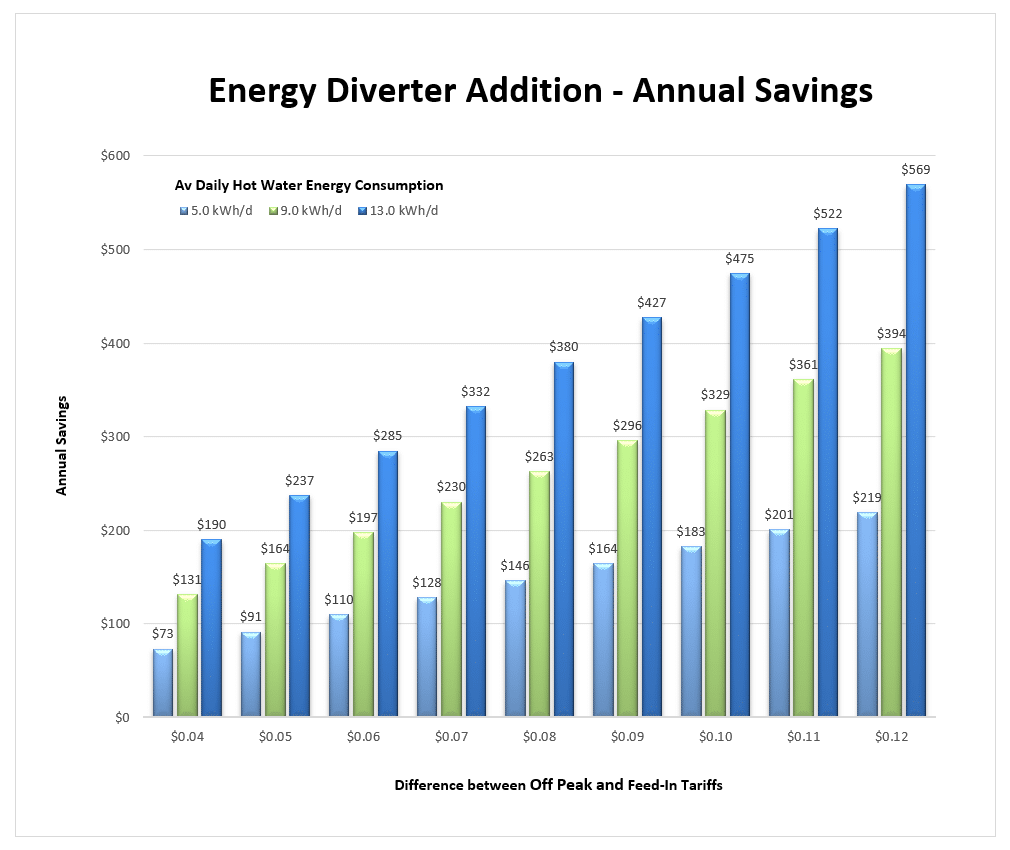Improve effectiveness of solar power with energy diversion
Surplus energy production from a solar power system can be used for water heating.
Current Trends
The ability to receive a high feed-in tariff for solar exported to the grid ($0.15+ per kWh) is getting harder to achieve. The tariffs quoted by the major energy retailers have been showing a downward trend recently, and although it is possible in some cases to get better than advertised, it can be assumed that this downward trend will continue.
Conventional wisdom suggests that this trend will give rise to increased uptake of batteries for energy storage as an addition to solar power systems. Currently, the cost of adding a battery can be quite prohibitive, so it is essential to know what your solar system can achieve to optimise the return on a proposed investment.
An alternative option to batteries, if you have electric hot water, is to use surplus solar energy for water heating.

Hot Water Production
Energy consumption for water heating is generally charged at off-peak rates and is metered separately from main tariff energy consumption. It is shown as Controlled Load (or CL) on your electricity bill.
When the off-peak rate charged for hot water production is close to the feed-in tariff received from solar export, there is no significant financial benefit to making a change. The credit for exported solar can off-set the cost of purchased off-peak energy for water heating at close to a 1:1 ratio.
Now that feed-in tariffs are trending downwards, the gap between the feed-in tariff and off-peak (CL) rates are becoming more significant. Therefore, having a solar power system provide the energy required for water heating becomes more attractive financially.
Using surplus solar energy production to supply power to a hot water system is achieved by integrating an Energy Diverter.
Energy Diverters are sophisticated devices that allow surplus solar production to be diverted to water heating instead of being sent to the grid. On low solar production days, the diverter will access grid power at off-peak (CL) or Time of Use (TOU) off-peak rates if required.
Financial Benefits
Two factors that influence the financial viability of adding an energy diverter are:
• The amount of energy used per day for hot water
• The difference between the off-peak rate and the feed-in tariff available.
The larger these values are, the greater the potential benefit.
○ Daily hot water energy usage can vary between 4kWh for a single person household and 14 kWh or more for a large family.
○ The difference between Feed-in Tariffs and Controlled Load Off-Peak Rates is commonly in the range of 7c to 10c per kWh.

The following graph shows how the annual benefit varies for different amounts of hot water energy consumption at different levels of variance between off-peak and feed-in tariffs.
Take Home Message
There are other methods of increasing self-consumption and improving the effectiveness of your solar power system besides adding batteries. Energy diversion for Hot Water production (and in some cases underfloor heating) is a viable low-cost option.
If you have an electric hot water system and want to use your solar energy production more effectively;
– check your bills and calculate your average daily hot water energy consumption
– check your feed-in tariff rate and off-peak purchase rate to calculate the difference
Contact us at SolarWise Wagga if you would like help with an evaluation.
Increase solar self-consumption - Catchpower
Self-consumption of solar generation is key to a profitable solar power system.
Addition of a Catchpower energy diverter to solar power is a great way to increase self-consumption by sending excess solar production to your electric hot water system rather than exporting it to the grid.

Want More Information?
If you would like to know more about using solar energy diversion for hot water, give us a call on
02 6971 0084 or enter your details in the enquiry form below.
Make an Enquiry
“At SolarWise Wagga our philosophy is simple, we aim to provide relevant and reliable information, quality service, and the highest grade of products at a competitive price.”









